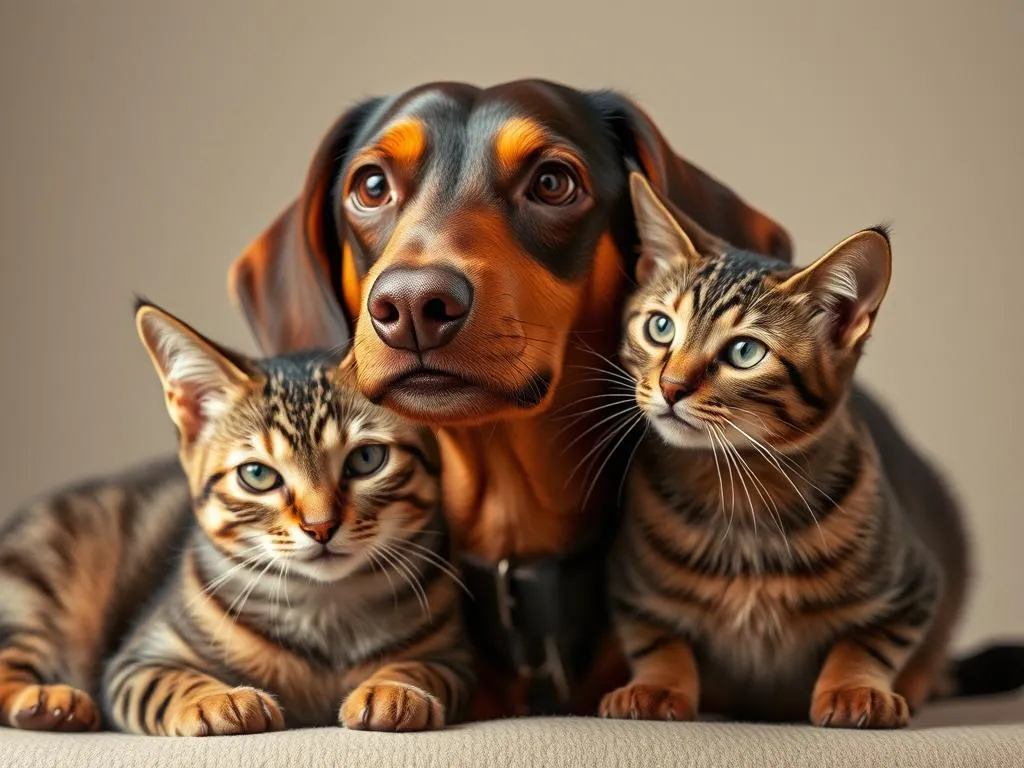
Introduction
Dachshunds, affectionately dubbed “wiener dogs,” are a beloved breed known for their long bodies and short legs. Originating in Germany, these little pups were bred primarily for hunting small game, which contributes to their feisty and energetic personalities. As a result, they possess a unique blend of curiosity, determination, and loyalty. Understanding will dachshund get along with a cat is essential for anyone considering adding both a dachshund and a cat to their home. Compatibility between pets can significantly influence their quality of life and the overall atmosphere of the household.
In this article, we will delve into the dynamics between these two species, exploring their personalities, social behaviors, and the factors that can influence their ability to coexist peacefully.
Understanding Dachshunds
History and Origin
The dachshund breed has a rich history that dates back to the 15th century. Originally bred for hunting badgers, the name “dachshund” translates to “badger dog” in German. Their elongated bodies and strong sense of smell made them excellent diggers and sprinters, allowing them to pursue prey into burrows. Over time, dachshunds have evolved into beloved companions, retaining their hunting instincts while adapting to family life.
Personality Traits
Dachshunds are known for their spirited and playful nature. They are often described as brave and confident, sometimes to the point of being stubborn. These traits can be charming but may also lead to challenges when integrating them with other pets, such as cats. Dachshunds tend to be social and enjoy the company of humans and other pets, but their territorial instincts can sometimes surface, particularly in the presence of smaller animals.
Socialization is crucial for dachshunds, as it can shape their temperament and behaviors towards other pets. Properly socialized dachshunds can be friendly and playful companions to cats, while those that are not may exhibit more aggressive or dominant behaviors.
Dachshund Breed Variations
Dachshunds come in two primary sizes: standard and miniature. Standard dachshunds generally weigh between 16 to 32 pounds, while miniature dachshunds typically weigh under 11 pounds. While both sizes share similar personality traits, their size can affect interactions with cats. A larger standard dachshund may inadvertently intimidate a smaller cat, while a miniature dachshund might be perceived as less of a threat. Understanding these differences is vital for predicting how a dachshund will behave around a cat.
Understanding Cats
Cat Behavior and Social Structure
Cats are known for their independent and territorial nature. Unlike dogs, cats do not have a pack mentality and often prefer to establish their own territories. This independence can make cats more unpredictable in their interactions with other pets, including dogs. A cat’s comfort level can significantly influence its willingness to accept a new canine sibling.
Typical cat behaviors include marking territory with scent, climbing to high places, and avoiding confrontation. They tend to be more cautious than dogs and may require more time to adjust to a new environment or companion.
Common Cat Breeds
Several cat breeds exhibit distinct personality traits that can influence their interactions with dogs. For example:
- Siamese: Known for their sociable and vocal nature, they often thrive in multi-pet households.
- Maine Coon: Gentle giants, they are known for their friendly disposition and can be more tolerant of dogs.
- Persian: Typically more reserved, they may not appreciate the playful antics of a dachshund.
Understanding the breed characteristics of your cat can help predict how they might react to the introduction of a dachshund into the home.
Factors Influencing Compatibility
Early Socialization
Introducing a dachshund to a cat at a young age can set the stage for a harmonious relationship. Early socialization allows both pets to become accustomed to each other’s presence and behaviors. Here are some tips for socializing dachshunds and cats together:
- Start slow: Begin by allowing them to sniff each other’s bedding or toys before any direct contact.
- Supervised interactions: Allow short, supervised meetings to gauge their reactions.
- Positive reinforcement: Reward both pets for calm behavior with treats and praise.
Individual Temperament
Each pet has its unique personality, which plays a crucial role in their ability to coexist. Some dachshunds may have a higher prey drive, making them more likely to chase a cat. Conversely, certain cats may be more assertive and unafraid to stand their ground. Assessing the individual temperaments of both pets can help you predict how they will interact.
Environment and Space
Creating a harmonious living environment is essential for successful pet integration. Here are some tips for establishing separate spaces:
- Safe zones: Provide each pet with a designated area where they can retreat if they feel overwhelmed.
- Vertical space: Cats often feel more secure when they have access to high perches, helping them to escape if necessary.
- Resources: Ensure that both pets have their own food, water, and litter boxes to reduce competition.
Introducing a Dachshund to a Cat
Preparation Before the Introduction
Before bringing a dachshund into a home with a cat, preparation is key. Here are steps to take:
- Set up safe spaces for the cat where the dachshund cannot reach.
- Familiarize the dachshund with the scent of the cat through bedding or toys.
- Establish boundaries to keep both pets safe during the initial meeting.
The Introduction Process
The introduction process should be gradual. Here’s a general guideline:
- Separate rooms: Keep the pets in separate rooms initially.
- Controlled meetings: Use a leash to control the dachshund during the first few meetings.
- Observe body language: Watch for signs of stress, such as hissing from the cat or growling from the dachshund.
Monitoring Interactions
Supervision is crucial during initial meetings. Here are tips for monitoring their interactions:
- Short sessions: Keep initial interactions brief to prevent overwhelming either pet.
- Calm environment: Maintain a calm atmosphere to reduce anxiety.
- Positive reinforcement: Reward both pets for positive behavior towards each other.
Troubleshooting Common Issues
Signs of Aggression
Recognizing aggressive behaviors in either pet is critical. Signs to look for include:
- Dachshund aggression: Growling, barking, or lunging towards the cat.
- Cat aggression: Hissing, swatting, or raised fur.
If aggression occurs, separate the pets immediately and reassess the introduction process.
Anxiety and Stress Management
Both pets may experience anxiety during the adjustment period. Signs of stress include:
- Dachshund: Excessive barking, pacing, or refusal to eat.
- Cat: Hiding, excessive grooming, or litter box avoidance.
To manage anxiety, consider the following techniques:
- Calming aids: Use pheromone diffusers or calming collars designed for pets.
- Routine: Maintain a consistent routine to provide a sense of security.
Professional Help
If challenges persist, seeking professional help may be necessary. A certified dog trainer or animal behaviorist can provide tailored guidance and strategies for integrating a dachshund and a cat.
Success Stories and Real-Life Examples
Positive Outcomes
Many pet owners have successfully integrated dachshunds and cats in their homes. One inspiring story involves a family who adopted a dachshund puppy alongside their adult cat. Through consistent positive reinforcement and gradual introductions, the two pets developed a strong bond, often seen cuddling together on the couch.
Lessons Learned
While many households experience success, challenges are common. Some pet owners have reported initial aggression from either side, but patience and persistence paid off. Typical tips include:
- Do not rush the process: Allow the pets to adjust at their own pace.
- Celebrate small victories: Acknowledge every step forward in their relationship.
Conclusion
In summary, the potential for a dachshund and a cat to coexist peacefully largely depends on their individual temperaments, early socialization, and the environment created by their owners. While challenges may arise, many mixed households thrive with patience and understanding. As pet owners, taking the time to consider compatibility carefully can lead to a rewarding relationship between a dachshund and a cat, enriching the lives of both pets and their families.
Whether you are a seasoned pet owner or considering welcoming a dachshund into a home with a cat, the journey can be fulfilling. With the right approach, these two furry companions can share a home filled with love and companionship.









